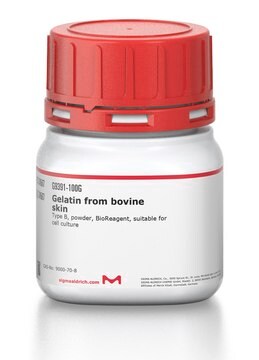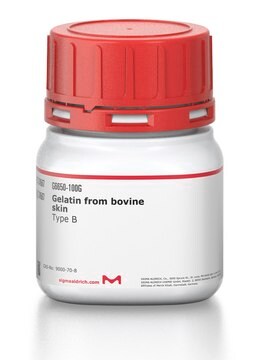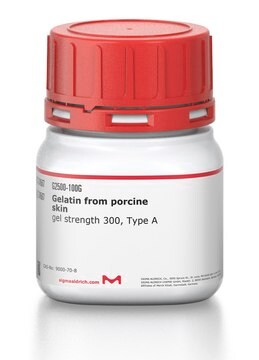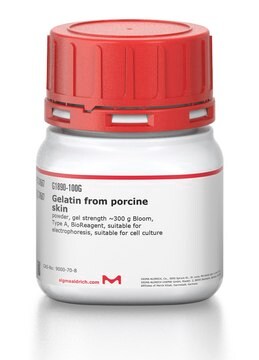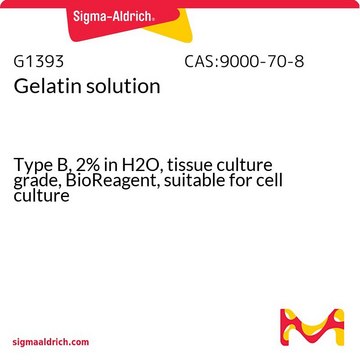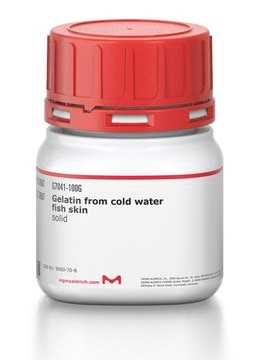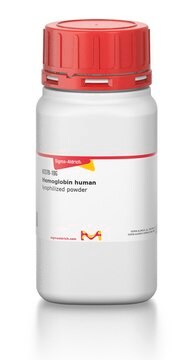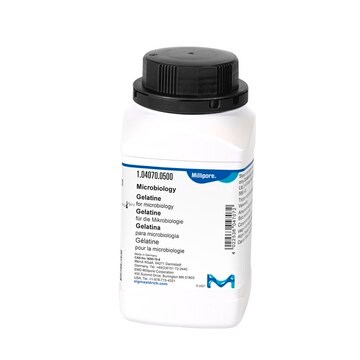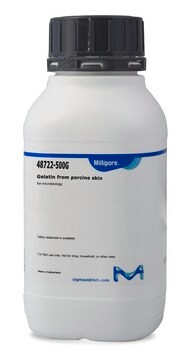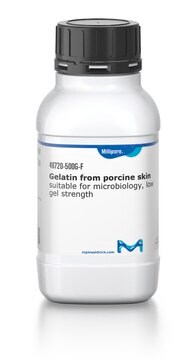G9382
Gelatin from bovine skin
gel strength ~225 g Bloom, Type B
Synonym(s):
Bovine gelatin
Sign Into View Organizational & Contract Pricing
All Photos(3)
About This Item
Recommended Products
biological source
bovine skin
Quality Level
type
Type B
Assay
≥95% protein basis (biuret)
form
powder
technique(s)
ELISA: suitable
cell culture | mammalian: suitable
immunocytochemistry: suitable
western blot: suitable
solubility
H2O: soluble 50 mg/mL
Looking for similar products? Visit Product Comparison Guide
Components
Gelatin is a heterogeneous mixture of water-soluble proteins of high average molecular masses, present in collagen. Proteins are extracted by boiling the relevant skin, tendons, ligaments, bones, etc. in water. Type A gelatin is derived from acid-cured tissue. Type B is derived from lime-cured tissue.
Caution
Dry gelatin, when stored in airtight containers at room temperature, will remain unchanged for many years. When heated at 100°C in the presence of air, it swells becomes soft and disintegrates to a carbonaceous mass with evolution of pyridine bases and ammonia.
Preparation Note
This product is derived from bovine skin. Gelatin is soluble in hot than in cold water. It is practically insoluble in most organic solvents such as alcohol, chloroform, carbon disulfide, carbon tetrachloride, ether, benzene, acetone, and oils. The Bloom number, determined by the Bloom gelometer, is an indication of the strength of a gel formed from a solution of the known concentration. The Bloom number is proportional to the average molecular mass. Bloom numbers of porcine skin Gelatin vary from 90 to 300 g. This product has a gel strength of 225.
Storage Class Code
11 - Combustible Solids
WGK
nwg
Flash Point(F)
Not applicable
Flash Point(C)
Not applicable
Personal Protective Equipment
dust mask type N95 (US), Eyeshields, Gloves
Choose from one of the most recent versions:
Already Own This Product?
Find documentation for the products that you have recently purchased in the Document Library.
Customers Also Viewed
Comparison of γ-radiation and electron beam irradiation effects on gelatin.
Vieira FF, et al.
Radiation Physics and Chemistry, 63, 331-332 (2002)
G Alessandri et al.
Cancer research, 43(4), 1790-1797 (1983-04-01)
An assay to measure endothelial cell mobilization on a gelatin substratum has been developed. Utilization of the gelatin-agarose and Boyden chamber assays established that: (a) fragments or extracts of corneas treated with several effectors of angiogenesis in vivo acquired the
K A van der Lee et al.
Journal of lipid research, 41(1), 41-47 (2000-01-11)
Long-chain fatty acids are the most important substrates for the heart. In addition, they have been shown to affect signalling pathways and gene expression. To explore the effects of long-chain fatty acids on cardiac gene expression, neonatal rat ventricular myocytes
Isolation and maintenance of symbiotic fungi of ants in the tribe Attini (Hymenoptera: Formicidae)
Silva-Pinhati A C O, et al.
Neotropical Entomology, 34, 1-5 (2005)
Substrate specificity of thermostable alkaline protease from Bacillus sp. No. AH-101.
H Takami et al.
Bioscience, biotechnology, and biochemistry, 56(2), 333-334 (1992-02-01)
Our team of scientists has experience in all areas of research including Life Science, Material Science, Chemical Synthesis, Chromatography, Analytical and many others.
Contact Technical Service